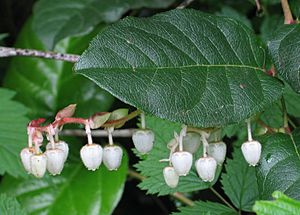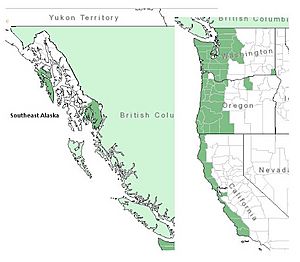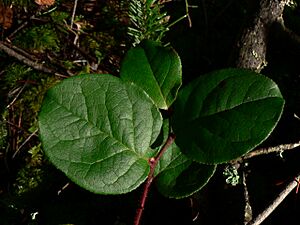Salal facts for kids
Quick facts for kids Salal |
|
|---|---|
 |
|
| Leaves and flowers | |
| Conservation status | |
| Scientific classification | |
| Genus: |
Gaultheria
|
| Species: |
shallon
|
 |
|
| Distribution in the United States | |
Gaultheria shallon is an evergreen shrub that belongs to the heather family. It is found naturally in western North America. In English, it is often called salal, shallon, or sometimes gaultheria.
Contents
What Salal Looks Like
Salal plants can grow from about 1.3 feet (0.4 meters) to 10 feet (3.05 meters) tall. They can spread out or grow straight up. Often, they form thick, dense patches that are hard to walk through. The twigs are reddish-brown and have bark that peels off. These twigs can live for many years, but they only have leaves for the first few years.
The leaves are always green, thick, and tough. They are shiny and dark green on top, and rougher and lighter green underneath. Each leaf is shaped like an egg and has tiny, sharp teeth along its edges. They are about 2 to 4 inches (5 to 10 cm) long. A single leaf usually stays on the plant for 2 to 4 years before a new one grows.
Salal flowers grow in a cluster called an inflorescence. This cluster is one-sided and has 5 to 15 flowers at the ends of the branches. Each flower has a deeply divided, five-parted outer leaf structure called a calyx. The petals (corolla) are urn-shaped, pink to white, and about 0.3 to 0.4 inches (7 to 10 mm) long.
The fruit of the salal is reddish to blue. It has a rough surface and tiny hairs. It's almost round and measures about 0.2 to 0.4 inches (6 to 10 mm) across. These fruits are not true berries but are called 'pseudoberries'. They have a fleshy outer part that comes from the calyx. Each fruit usually contains about 126 small, brown seeds.
Where the Name Salal Comes From
The explorers Lewis and Clark heard the local Chinook Jargon name for this plant, which sounded like shallon, shelwel, or shellwell. However, when Scottish botanist David Douglas arrived in Oregon in 1825, he noted that people called it salal or sallal.
The name of the plant group, Gaultheria, was given by Pehr Kalm. He named it after his guide in Canada, another botanist named Jean François Gaultier.
In the Squamish language, the fruits are called t’áḵa7, and the bush itself is called t’áḵa7áy̓. In the Lushootseed language, the month of August is named pədt̕aqaʔ, which means 'time of the salal'.
Where Salal Grows
Salal is found in western Alaska, British Columbia, Washington, Oregon, and along much of the California coast. It grows as far north as Baranof Island, Alaska. In the California Coast Ranges, it often grows near Western poison oak.
Salal in Europe
Salal was brought to Britain in 1828 by David Douglas. He wanted the plant to be used as an ornamental (a plant grown for its beauty). People believe it was planted there to provide cover for pheasants on hunting estates.
Salal's Environment
Where Salal Grows Best
Gaultheria shallon grows in damp or dry forests, from mountains to coastal areas. It also grows in wet peatlands and swamps across the Pacific Northwest down to Southern California. It is a common plant found under the trees in conifer forests, especially where there isn't too much shade. It can take over large areas because it spreads using underground stems called rhizomes. Individual plants can live for hundreds of years by spreading this way. Salal doesn't like frost.
It can handle salt spray and grows well on stable sand dunes, open slopes, and cliffs near the ocean. It also thrives in coastal brush areas and forests with shore pine and Sitka spruce. Salal can grow in moderate shade and does well in sunny spots too.
It grows in many types of soil but prefers moist, sandy, or peaty soils. It often starts growing on rotting wood and stumps or as an epiphyte (a plant that grows on another plant) in very humid places.
New conifer trees often grow better where salal is present than where other plants like western swordfern or vine maple dominate. However, salal still competes with young conifer trees for water, nutrients, and space. There are different ideas about how it affects Douglas-fir regrowth. On some sites, it might slow growth, but on others, it might add nutrients to the soil and actually help new conifer trees grow.
Animals and Salal
The leaves of salal are eaten by deer and elk. It is an important winter food for these animals. They eat more salal when other low-growing plants are covered in snow. For example, in Western Washington, salal leaves made up about 30% of a deer's diet in January, but only 0.5% in June. The leaves don't have a lot of nutrients. Deer that eat only salal have shown signs of not getting enough food. This shows that salal is mainly a winter or emergency food for these large animals. Beavers and the white-footed vole also eat salal leaves, as do domestic goats and sheep in some areas.
Many birds, like the band-tailed pigeon, wrentit, different types of grouse, and various songbirds, eat the fruit. Mammals such as the red squirrel, black bear, black-tailed deer, Townsend's chipmunk, and the Douglas squirrel also enjoy the berries.
Salal flowers are pollinated by hummingbirds, bees, and flies. Deer also browse (eat) the flowers.
Salal provides important cover and hiding places for many animals, from large deer to small birds and mammals.
Salal and Fire
Salal is able to survive fires that happen every 50 to 500 or more years. Even if the parts of the plant above ground are burned, the underground stems (rhizomes) will survive. They will then sprout new growth after light to moderate fires. Severe fires in dry, shallow soil can reach the roots and kill the plant.
When Salal Spreads Too Much
Salal can easily grow in heathland and acidic woodland areas in southern England. It often forms very tall and thick evergreen patches that can cover up other plants. People who manage heathlands often see it as a problem weed when the land is not managed. However, cattle will eat salal, especially in winter. So, where traditional grazing (letting animals eat plants) has been brought back, the dense salal patches break up, and the plant becomes a more scattered part of the heathland.
As an invasive species (a plant that spreads aggressively and harms native plants), salal is hard to get rid of with many herbicides because its leaves are waxy. However, some chemicals like Garlon and Silvex can work if used correctly. Trying to remove it by hand or machine might break up the rhizomes, which can actually make new growth appear and increase the amount of salal.
How People Use Salal
The dark blue berries and young leaves of salal are edible. They can also help reduce appetite. Both have a unique flavor. The berries were a very important food source for some Native American tribes. They ate them fresh and also dried them into cakes. The berries were also used as a sweetener. The Haida used them to thicken salmon eggs. Sometimes, the plant's leaves were used to flavor fish soup.
More recently, the berries are used locally to make jams, preserves, and pies. They are often mixed with Oregon-grape berries because salal's mild sweetness helps to balance the tartness of the Oregon-grape.
Salal is widely grown as an ornamental plant both in its native areas and elsewhere. It's useful for ground cover and for making gardens look nice.
In the Pacific Northwest, harvesting Gaultheria shallon is part of a big business. This industry supplies cut evergreens all over the world for use in floral arrangements. It is also used in native plant gardens and sold as "Lemon Leaf."
Salal's Medicinal Uses
Local native people have used salal for its medicinal properties for many generations, though these uses are not widely known. The leaves have an astringent effect, which means they can help tighten tissues. This makes them useful as an anti-inflammatory (to reduce swelling) and anti-cramping herb. Leaves prepared as a tea or a tincture (a liquid extract) are thought to help reduce internal swelling, like bladder inflammation. They may also help with stomach or duodenal ulcers, heartburn, indigestion, sinus inflammation, diarrhea, mild fever, sore throats, and menstrual cramps. A poultice (a soft, moist mass of leaves) made from the leaf can be placed on the skin to help with discomfort from insect bites and stings.
See also
 In Spanish: Gaultheria shallon para niños
In Spanish: Gaultheria shallon para niños




